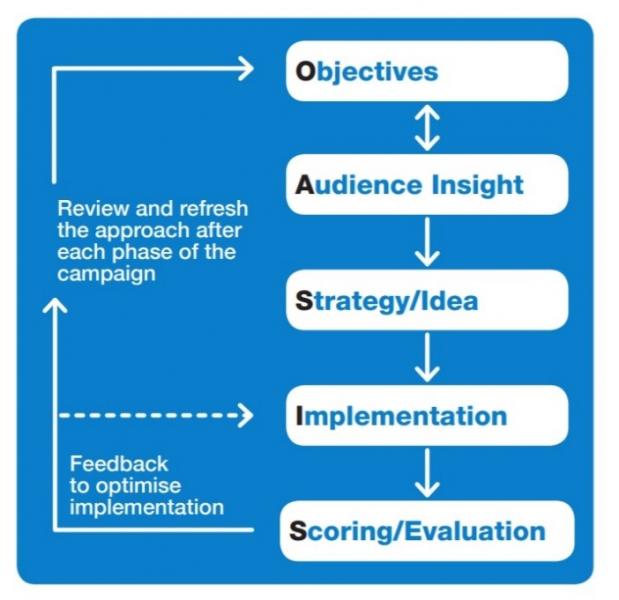Everyone involved in public sector PR and comms should be aware that Whitehall now insists that “all government communications professionals, regardless of discipline or organisation” are required to use the OASIS methodology for “every kind of planned communication and campaign.
OASIS stands for Objective, Audience/Insight, Strategy/Ideas, Implementation and Scoring/Evaluation, as illustrated below, and the Cabinet Office says that its purpose is to ensure that all government supported marketing and PR campaigns are ‘effective, efficient and evaluated’.

Beginning with a clearly defined and measurable set of campaign objectives is, of course, essential, but the OASIS methodology then moves on to ‘Audience Insight’, which, to me, at least, seems a curiously imprecise term.
According to whichever dictionary is used, ‘Insight’ is variously defined as “a clear, deep, and sometimes sudden understanding of a complicated problem or situation” or “the ability to understand ‘one's own problems” and “the inner nature of things”.
This seems to be a strange way of constructing a strategy, especially as an understanding of the nature and needs of your audience is the foundation upon which all subsequent campaign activity is built.
This is then followed by another equally imprecise term, ‘Strategy/Idea’and endswith‘Scoring/Evaluation’althoughsome on-line sources say that this ‘S’ stands for ‘Sustainment’.
It’s hard not to think that the format of this model has been dictated by the need to give it a catchy mnemonic name, instead of developing a structured and tested methodology?
Segmentation ‘The Heart of Modern Marketing’
Most marketing professionals and academics would seek to secure the above ‘audience insight’ via the use of ‘market segmentation’, a methodology developed in the USA by professor Philip Kotler, one of the world’s leading marketing practitioners, academics and high-level government-level consultants
Kotler describes segmentation as ‘the Heart of Modern Marketing’ and uses it as the first and most important phase of his ‘Segmentation, Targeting and Positioning’ methodology (‘SMT’ for brevity).
This might not be such a slick title but it does provide a tried and tested academic, operational and commercial framework for the planning and execution of all types of marketing campaign.
Segmentation
Kotler says that market segmentation enables a marketeer to ‘make sense’ of an undifferentiated market by dividing it into groups of actual or potential customers who share the same characteristics and the same needs.
The members of these market segments, can then be usually reached by the same media.
This approach makes subsequent marketing communications and campaigns more efficient, more effective and more ‘actionable’ as the members of these segments will feel that the seller really does knows them and understands their needs.
For instance, not all holiday-makers want to lie on a beach, some want adventure.
Not all car drivers want status and speed, some want reliability and comfort.
Not all businesses sell direct to the public, many sell B2B.
Bald men don’t need combs!
This is why market segmentation is the first and, without doubt, the most important element of any marketing strategy.
Targeting
Targeting is the process of deciding which market segments are likely to be the most responsive, the most likely to purchase a product or products and, therefore, the most likely to provide the best return on the marketing spend.
Market targeting is a dynamic process. Fashions change; technology advances; markets become saturated; products become stale and new advertising media evolves.
This means that marketing spend has to be dynamic and has to be able to target and reach the most responsiveness markets, ranked, for instance, by size, value, location, ability to reach and, especially, readiness and ability to purchase.
Positioning
Kotler defines positioning as, “designing a company's offering and image so that it occupies a meaningful and distinct competitive position in the target market's mind”, or, more directly, “getting (your product) inside your prospect’s mind”.
Positioning goes beyond advertising; it uses language, images, music and role models and even ‘influencers’ (!) etc to ‘plant’ ideas inside the prospective purchaser’s mind and, to clarify the product or service’s ‘points of difference’ and its ‘competitive advantages’.
Positioning is most effective when it shows the product delivering the promised benefits and outcomes, placing it ‘top of mind’.
Perhaps best of all, segmentation reduces the possibility of a mistaken purchase. After all, if the seller knows the buyer’s needs and his/her characteristics and understands his/her mind there’s not much that can go wrong!
Postscript
The UK government is aware of Kotler’s contribution to marketing strategy as it previously provided public sector managers in the UK with international scholarships to study segmentation, targeting and positioning at Northwestern University in Evanston, Chicago.
I was lucky enough to win one of these week-long scholarships and was amazed to discover upon arrival in Chicago that the course tutor was Professor Philip Kotler himself!
About Philip Cooke
Philip Cooke and is a recent member of the PRCA’s Government Group and he established the Gloucester-based Destination Marketing Group in 2000 as a specialist tourism, leisure and urban regeneration marketing consultancy.
Before launching his own company, Philip was Gloucester City Council’s Director of Tourism, Marketing and City Centre Manager and in 1992 he was the UK Government’s Public Sector Manager of the Year.
